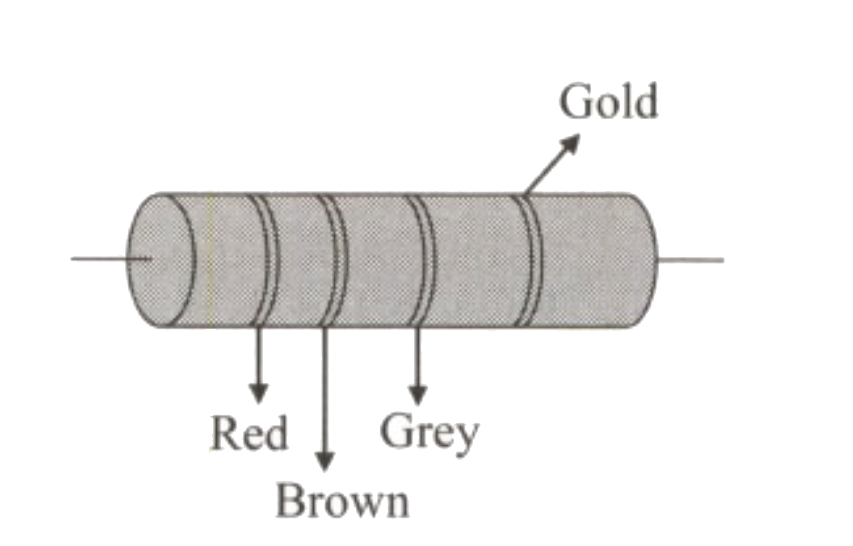The colour coded resistance of carbon resistance is (initial three bands are red and fourth band is silver)
222Ω±10%
2200Ω±10%
333Ω±5%
33000Ω±10%
The correct Answer is:B
To determine the resistance value from the color-coded bands of a carbon resistor, we will follow these steps:
1. Identify the Colors: The resistor has the following color bands:
- First band: Red
- Second band: Red
- Third band: Red
- Fourth band: Silver
2. Refer to the Color Code Chart: We will use the standard color code chart for resistors:
- Red corresponds to the number 2.
- The third band (multiplier) also needs to be considered.
3. Determine the Value from the First Two Bands:
- The first band (Red) gives us the first digit: 2.
- The second band (Red) gives us the second digit: 2.
- Therefore, the first two bands together give us the number: 22.
4. Determine the Multiplier from the Third Band:
- The third band (Red) indicates a multiplier of 102 (which is 100).
5. Calculate the Resistance:
- Combine the digits obtained from the first two bands with the multiplier:
Resistance=22×102=22×100=2200Ω
6. Determine the Tolerance from the Fourth Band:
- The fourth band (Silver) indicates a tolerance of ±10%.
Final Result:
The resistance value is 2200 Ω with a tolerance of ±10%.
---
- First band: Red
- Second band: Red
- Third band: Red
- Fourth band: Silver
- Red corresponds to the number 2.
- The third band (multiplier) also needs to be considered.
- The first band (Red) gives us the first digit: 2.
- The second band (Red) gives us the second digit: 2.
- Therefore, the first two bands together give us the number: 22.
- The third band (Red) indicates a multiplier of 102 (which is 100).
- Combine the digits obtained from the first two bands with the multiplier:
Resistance=22×102=22×100=2200Ω
- The fourth band (Silver) indicates a tolerance of ±10%.
The resistance value is 2200 Ω with a tolerance of ±10%.
Topper's Solved these Questions
- BOOK - NARAYNACHAPTER - CURRENT ELECTRICITYEXERCISE - Level 2 C.W59videos
CURRENT ELECTRICITY
- BOOK - NARAYNACHAPTER - CURRENT ELECTRICITYEXERCISE - Level 2 H.W45videos
CURRENT ELECTRICITY
- BOOK - NARAYNACHAPTER - CURRENT ELECTRICITYEXERCISE - Level 1 C.W64videos
CURRENT ELECTRICITY
- BOOK - NARAYNACHAPTER - COMMUNICATION SYSTEMEXERCISE - Level-II(H.W)25videos
COMMUNICATION SYSTEM
- BOOK - NARAYNACHAPTER - DUAL NATURE OF RADIATION AND MATTEREXERCISE - ASSERTION AND REASON15videos
DUAL NATURE OF RADIATION AND MATTER
Similar Questions
Knowledge Check
- Question 1 - Select One
The color code of a resistance of a resistance is given below:

The values of resistance and tolerance, respectively, are:A47 kW, 10%B4.7 kW, 5%C470 W, 5%D470 kW, 5% - Question 2 - Select One

Find the value of colour coded resistance shoen in fig.A520±10%B5200±1%C52000±10%D52000±1% - Question 3 - Select One
The resistance of carbon _______ with rise in the temperature.
AincreasesBdecreasesCremains the sameDfirst increases then decreases
The value of the resistance of a carbon resistor having the standard colour - coding as shown in the figure is nGΩ±5%. What is the value of n ?
 View Solution
View SolutionThe value of the resistance of a carbon resistor having the standard colour - coding as shown in the figure is nGΩ±5%. What is the value of n ?
 View Solution
View SolutionThe color code of a resistance is given below:

The value of resistance and tolerance , respectively areView SolutionIn the colour coding system of carbon resistors, the tolerance (in %) shown by gold band is____.
View SolutionWhat is the resistance of a carbon resistance which has bands of colours brown, black and brown
View Solution

